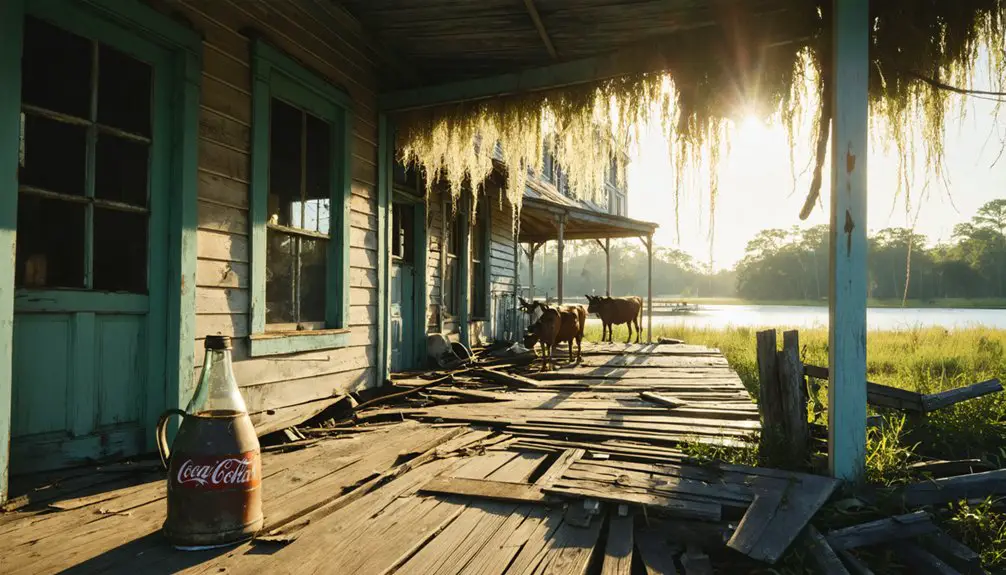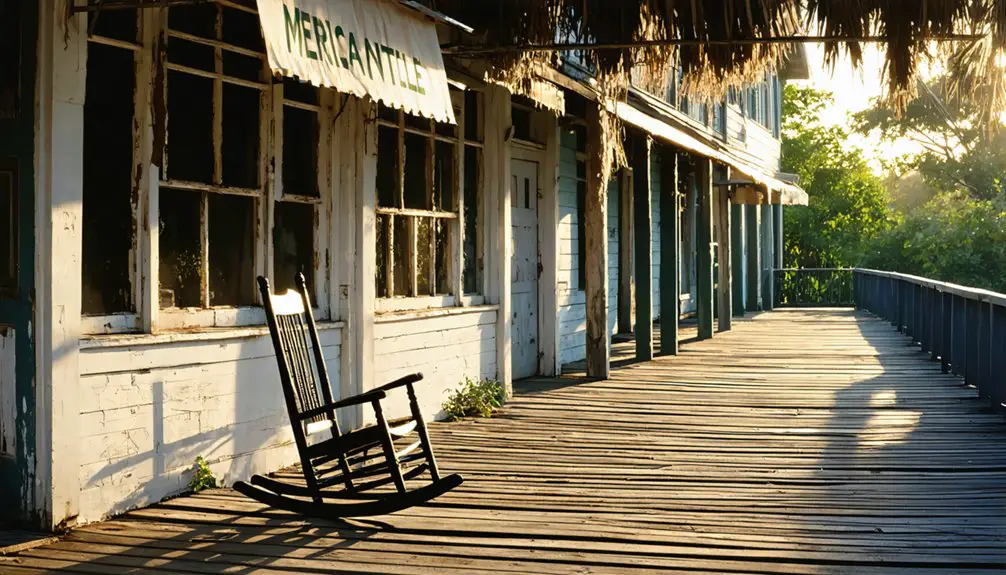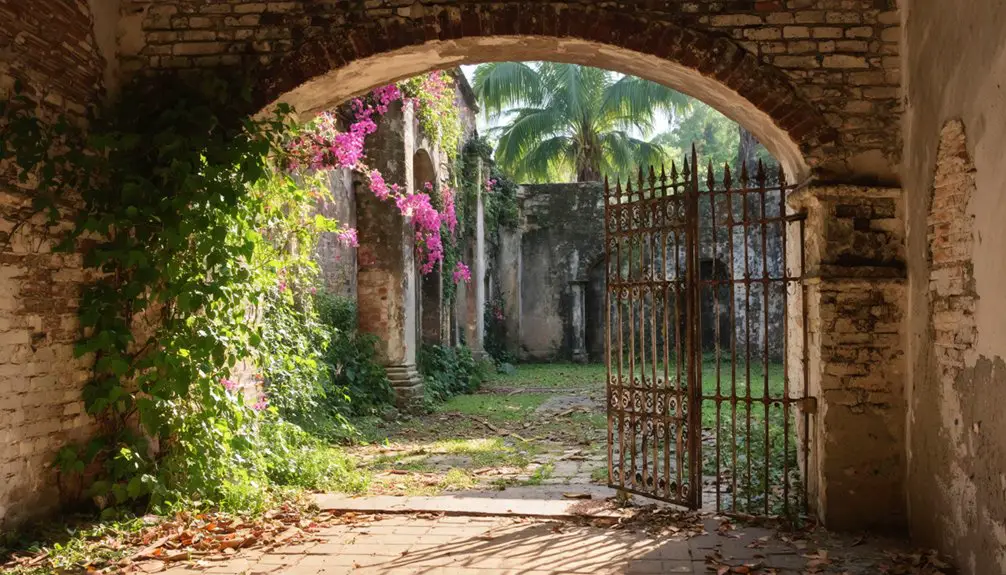You’ll find striking parallels between California and Florida’s frontier ghost towns, both shaped by 19th-century resource extraction and transportation networks. While California’s communities centered on gold mining, Florida’s towns emerged around industries like phosphate mining and lumber. The towns’ rapid rise and fall followed similar patterns, with populations peaking in the 1870s before declining due to resource depletion. Their preserved structures and artifacts now offer fascinating windows into pioneer life, with each state’s unique narrative waiting to be uncovered.
Key Takeaways
- Both California and Florida face preservation challenges in their ghost towns due to increasing visitor numbers and limited funding.
- Heritage tourism initiatives attempt to preserve historical sites while adapting them for modern tourist activities and festivals.
- Mining boom towns in California contrasted with Florida’s ghost towns, which developed through different historical and economic circumstances.
- Tourism management strategies are needed in both states to protect historic structures while accommodating growing visitor interest.
- Preservation efforts in both regions struggle with demographic changes and evolving tourism patterns affecting site maintenance.
Origins and Early Settlement
Three primary factors drove the establishment of Old California ghost towns in the 19th century: mining booms, transportation networks, and natural resource extraction.
You’ll find these settlements emerged around valuable mineral deposits, particularly gold and silver mines, creating single resource economies that shaped the region’s development.
Rail transportation proved essential to these early communities’ survival, as you’d need reliable shipping routes to export minerals and sustain economic viability.
Without reliable rail networks to transport precious minerals, early California settlements struggled to maintain their economic lifelines.
Towns bypassed by railroads often faced rapid decline. Similar to Florida’s pattern of boom-bust cycles, these settlements experienced rapid growth followed by dramatic economic downturns. Environmental challenges, including water scarcity and harsh conditions, tested settlers’ resilience. The famous town of Bodie, California still has approximately 110 structures standing today as a testament to this era.
While some settlements adapted, others couldn’t overcome these obstacles.
Unlike Florida’s ghost towns, which often originated from logging industries, military forts, or strategic installations, California’s abandoned settlements primarily reflected the boom-and-bust cycle of mining operations and their dependence on rail connections.
The Rise and Fall of a Frontier Town
When frontier towns first emerged across California’s rugged landscape, they followed a predictable pattern of rapid growth and eventual decline tied to their economic foundations.
Town development accelerated rapidly during boom periods as industries like mining and lumber attracted workers seeking opportunity and independence. However, economic decline proved inevitable for settlements dependent on finite resources. These towns often supported industries like lumber mills that could employ over 1,000 workers at their peak. Towns like Bodie Ghost Town drew thousands of residents during the silver mining boom of the late 1800s.
Here’s what sealed the fate of these frontier communities:
- Depletion of natural resources like gold and timber led to mass exodus as jobs disappeared.
- Transportation changes, especially new railroad routes, bypassed established towns and drained their commercial significance.
- Single-industry dependence left communities vulnerable when market demands shifted or technology evolved.
You’ll find that many of these once-thriving settlements transformed into ghost towns, their abandoned buildings standing as silent testimony to the boom-and-bust cycle of frontier life.
Life in Old California’s Heyday
Life in California’s frontier towns during their heyday revealed a complex tapestry of survival, opportunity, and social chaos. You’d find yourself maneuvering a world where mining culture dominated every aspect of daily life, from the thundering stamp mills crushing 100 tons of ore per day to the dangerous work that claimed the lives of one in five miners within six months.
The social dynamics swung between extremes – you could attend church on Sunday morning, then spend your evening in one of 65 saloons or gambling halls. Opium dens flourished alongside these establishments, adding to the town’s notorious reputation. In 1879, the population peaked at 8,500 with over 2,000 buildings dotting the landscape.
While volunteer fire companies and miners’ unions brought structure, the greeting “Have a man for breakfast?” reminded everyone of the nightly violence.
Despite harsh conditions, with temperatures plunging to -18°F, communities managed to establish schools, newspapers, and merchants that served up to 10,000 residents in boom times.
Preserved Structures and Notable Landmarks
When you explore the preserved buildings of California’s ghost towns, you’ll discover foundations and structures that tell stories of the state’s pioneering past.
The remaining physical landmarks, like Bodie’s schoolhouse with its original 1940s maps and blackboards, offer authentic glimpses into daily frontier life. Walking through 170 preserved buildings provides visitors with an immersive historical experience of this former gold mining town.
These architectural remnants stand as material evidence of California’s shift from mining boomtowns to carefully preserved historical sites. The site now draws tens of thousands of visitors annually who come to witness this remarkable slice of American history.
Historical Building Foundations
Throughout California’s historic ghost towns, the preserved building foundations reveal sophisticated 19th-century construction methods and architectural adaptability.
You’ll find these structures showcase the ingenuity of Gold Rush-era builders who utilized locally sourced foundation materials like adobe, slate, rock, and brick to create lasting establishments.
- The 1852 Old City Hotel in Sonora demonstrates multi-use architectural styles, combining hotel rooms, saloons, and dining areas within a single durable structure.
- Walter Knott’s preservation work in Calico Ghost Town maintains five original buildings that exemplify authentic mining town architecture.
- Mercantile establishments and saloons feature historically accurate window framing and foundation stabilization techniques that have withstood desert conditions.
These foundations continue to support structures that have adapted from their original purposes to serve as museums and historical sites, while maintaining their architectural integrity. The discovery of tunnels beneath downtown Sonora provides additional evidence of the town’s extensive mining infrastructure and architectural complexity. Similar to Florida’s Croom, the town’s phosphate mines left lasting structural imprints that reveal the industrial heritage of the region.
Physical Landmark Remnants
California’s ghost towns boast an impressive array of physical landmarks that stand as silent witnesses to the state’s Gold Rush heritage.
You’ll discover pristine examples of historical landscapes at Bodie State Historic Park, where a weathered Shell gas station, stamp mill, and church remain frozen in time. Ghost town remnants showcase authentic period details, from a rusting 1937 Chevy Coupe to original interiors maintained against decay.
The region’s industrial heritage lives on through preserved blacksmith shops, steam locomotives, and railroad depots.
At Old Sacramento’s 28-acre National Historic Landmark District, you can explore underground tunnels and witness Gold Rush architecture firsthand. These physical remnants, from wooden sidewalks to historic cemeteries, create an immersive window into 19th-century life, allowing you to experience California’s pioneering spirit in its most genuine form.
Historical Artifacts and Daily Life

As you explore the town’s historical sites, you’ll find preserved mining tools and domestic objects that reveal the daily routines of 19th-century frontier life.
The layout of living spaces, from modest miners’ cabins to larger merchants’ homes, reflects the social hierarchy and living conditions of the era.
Personal artifacts discovered in these structures, including cookware, clothing items, and work implements, provide tangible evidence of how residents managed their households and earned their livelihoods in this remote mining community.
Preserved Tools and Objects
Remarkable artifacts and tools scattered throughout these ghost towns provide tangible links to America’s pioneering past.
You’ll find mining relics like pickaxes and dynamite casings that tell stories of ambitious prospectors searching for gold and silver.
Industrial artifacts, including lumber mill foundations and cattle dipping vats, showcase the diverse economic activities that once thrived in these settlements.
- Original mining equipment reveals mineral-rich veins containing copper, lead, and silver
- Preserved general store shelves display consumer goods exactly as they were left
- Workwear items like company-issued denim coveralls paint a picture of daily labor life
These authentic remnants let you step back in time, offering a raw glimpse into the determination and grit of America’s frontier settlers who carved out their existence in these now-abandoned towns.
Living Spaces and Layout
Throughout these abandoned settlements, diverse living spaces reveal distinct social hierarchies and daily life patterns of their former residents.
You’ll find Eagle Mountain‘s 400-plus abandoned homes ranging from simple trailers to boarding houses, reflecting the town’s social stratification. The architectural styles showcase mid-20th century design with dedicated spaces for living, cooking, and sleeping.
Inside these ghost town structures, you’ll discover remnants of domestic life: peeling wallpaper, wood stoves, and basic furnishings.
The towns’ layouts tell stories of community planning, from Eagle Mountain’s extensive amenities to Jensen Beach’s mixed-use development.
Root cellars and stairways in places like Mannfield hint at pre-modern food storage solutions, while scattered power fixtures and air conditioning units show attempts to modernize before desertion.
Daily Activities and Routines
Life in these mining settlements revolved around the rhythmic pulse of resource extraction, with daily routines shaped by the demands of underground work and surface operations.
You’d find miners spending long hours maintaining tunnels and removing waste, while surface workers managed supplies and logistics. Daily routines extended beyond the mines into the town’s commercial spaces, where general stores and bars served as crucial communal gathering points.
- Your morning might start with essential mine maintenance and ore extraction.
- You’d break for supply runs to local merchants who kept detailed records in their cash registers.
- Your evenings would often include social activities at local establishments, where you’d exchange news and correspondence.
Even animal care, particularly of goats, provided structure to your day, offering moments of respite from the constant focus on mining operations.
Ghost Town Tourism and Preservation

Modern ghost town tourism in Florida presents a complex picture of both opportunity and challenge. While the state’s overall tourism trends show record-breaking numbers with 143 million visitors in 2024, local economies in historic areas face preservation challenges due to shifting visitor demographics.
You’ll find ghost towns struggling with funding shortfalls as seasonal patterns create unstable revenue streams, despite heritage tourism efforts to attract history enthusiasts. The impact is particularly visible in coastal communities, where some areas report 30% drops in business revenue.
To maintain economic sustainability, you’re seeing communities turn to adaptive reuse strategies, transforming historic sites into venues for festivals and arts events. Yet the future of these preservation efforts remains uncertain as tourism patterns continue to evolve.
Legacy in Florida’s Rural History
Florida’s ghost towns stand as powerful monuments to the state’s complex rural development, with abandoned settlements scattered across its interior landscape.
These forgotten places reveal the cultural significance of industries that once defined rural Florida’s identity, from logging camps to turpentine settlements.
Long-abandoned industrial sites speak volumes about rural Florida’s heritage, from the quiet ruins of sawmills to ghostly turpentine camps.
You’ll find these remnants of economic decline tell a compelling story about the state’s boom-and-bust cycles:
- Industrial heritage sites like Atsena Otie Key’s cedar mills showcase Florida’s crucial role in national commerce.
- Settlement patterns visible in places like Mannfield demonstrate how transportation routes shaped community survival.
- Physical artifacts and ruins serve as tangible links to understanding regional adaptations and community resilience.
When you explore these abandoned places, you’re witnessing intervals of neglect that shaped Florida’s distinctive rural character and economic evolution.
Frequently Asked Questions
Why Was Old California Named After the Western State?
You’ll find the town’s origins likely drew from California’s history of prosperity during the Gold Rush era, with settlers using the name to evoke similar promises of opportunity and success.
Were There Any Famous Outlaws or Crimes Associated With Old California?
Like a ghost in the wind, you won’t find famous outlaws or notorious crimes here – unlike California’s wild west towns, this Florida settlement focused on peaceful pursuits like farming and trading with Seminoles.
What Natural Disasters Affected the Town Besides Fires?
You’ll find flood events and potential earthquake impacts shaped this region, though specific records don’t detail major disasters besides fires that affected the settlement’s structures and community development.
Did Native American Tribes Have Settlements Near Old California?
You’ll find extensive Native settlements in this region, with tribal history showing populations of 100,000-300,000 before European contact. Villages varied from small desert communities to large coastal settlements exceeding 1,000 inhabitants.
Was Gold or Silver Mining Ever Attempted in Old California?
Picture miners panning streams in 1848: You’ll find that gold mining dominated Old California’s history, with prospectors using various mining techniques after James Marshall’s famous gold discoveries at Sutter’s Mill sparked the rush.
References
- https://historicarchaeology.weebly.com/journal/venus-in-florida-ghost-town-101
- https://freepages.history.rootsweb.com/~gtusa/usa/fl.htm
- https://www.florida-backroads-travel.com/old-venus-a-florida-ghost-town.html
- https://www.youtube.com/watch?v=Q_yjBgICWl8
- http://www.gribblenation.org/2018/06/ghost-town-tuesday-mannfield-fl-and.html
- https://www.geotab.com/ghost-towns/
- https://www.journaloffloridastudies.org/0102ghosttowns.html
- https://www.youtube.com/watch?v=-FCCbP_Q0O8
- https://www.thetravel.com/skip-bodie-for-abandoned-ghost-towns-in-florida/
- https://www.youtube.com/watch?v=CBFrK-n4HmA



